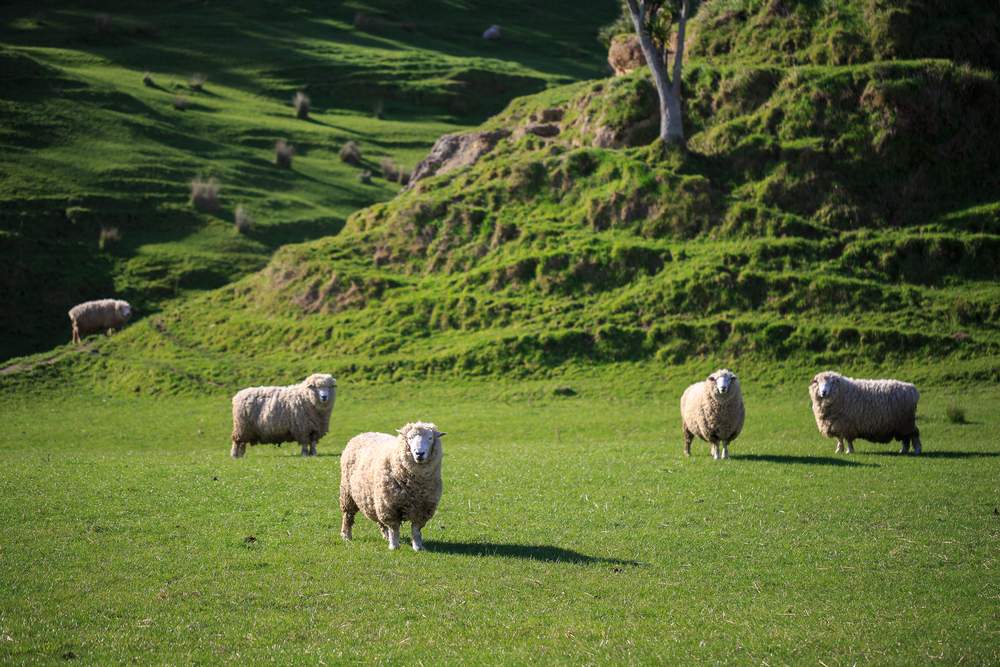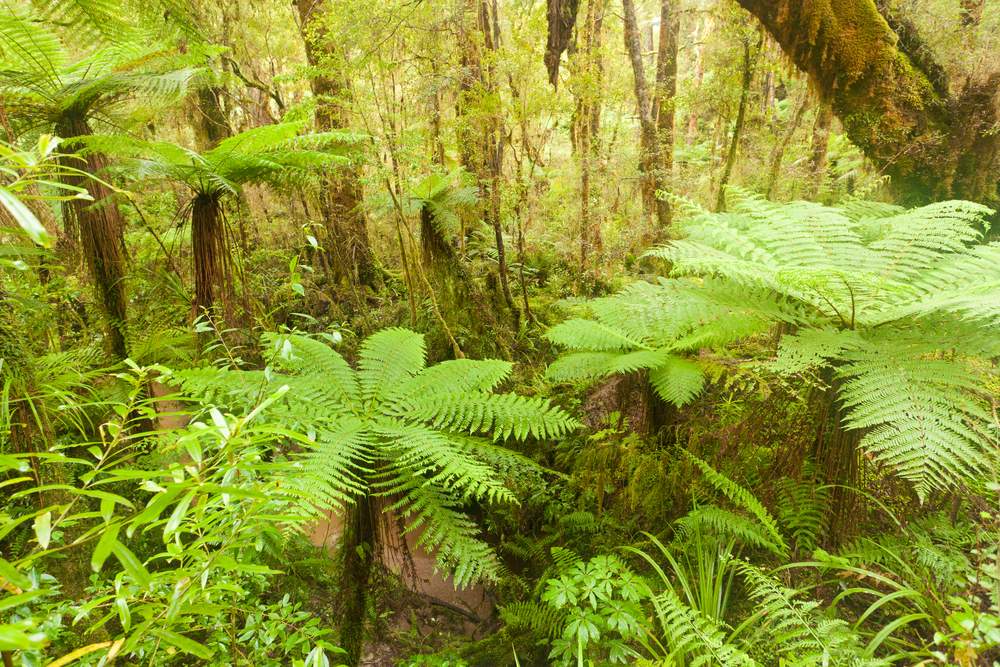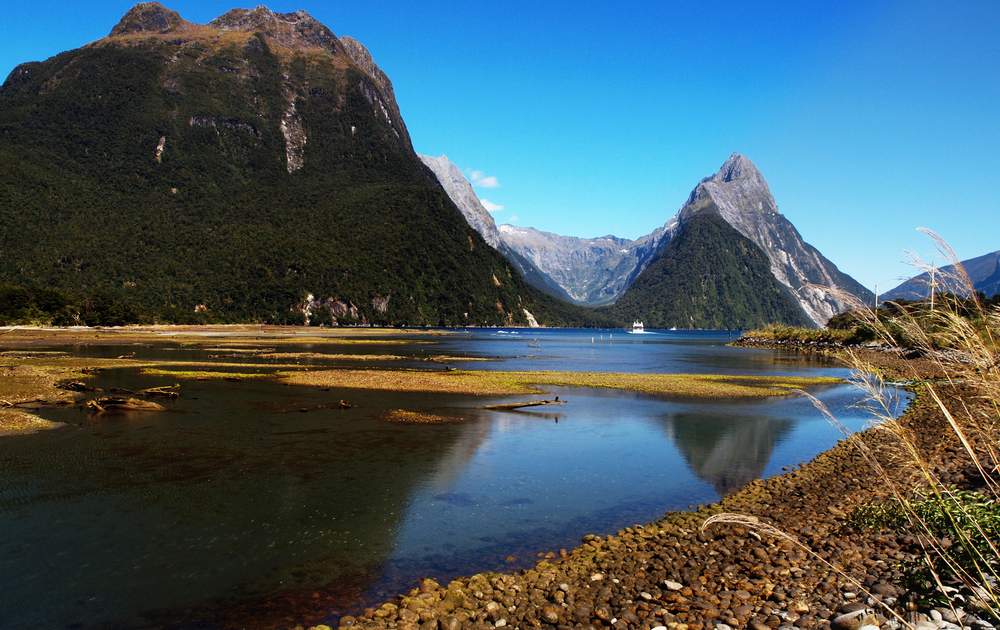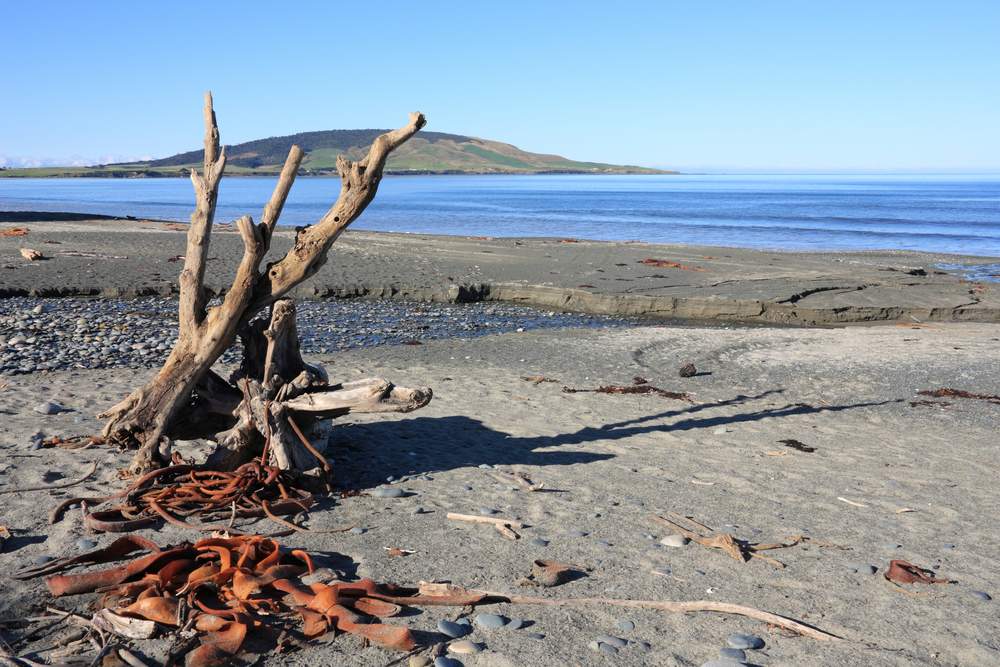If you were to send your five-year-old out into the front yard armed with three jumbo bags of cotton balls and the instruction to distribute them evenly across the entire green space, the result would approximate the manner in which sheep dot the landscape of the hillsides of New Zealand.
“The sheep are everywhere, and there are more than a few tucked into unexpected places.”
Long, pristine beaches with a rainbow of white, brown, and black sand lay like a ruffle along the hem of the island, the fancy fringe on an ancient elegance. Smoking thermal pools and the occasional snow topped mountain presiding over the steel blue of Lake Taupo round out one of the most diverse landscapes we’ve had the privilege of exploring.
Green Hills

The hillsides are a blanket of verdant greens and golden yellows, from the deep, black green of the dark pine forests, to the brown-green of the giant ferns, and every shade of kiwi in garden and grove. The quilt is divided into perfect patchwork sections by the even stitches of fencing, running over the high mountain passes between sheep and deer fields and across the central plain of a valley between cows and horses.
The squares are embroidered by the delicate terraced lines, beaten into hillsides by the trimmed hooves of ewes leading their little lambs between green pastures and cold rivers fed by icy springs that tumble, laughing, over the pebbled grooves that run deep between the hills.
A Fairy World of Ferns

New Zealand is a fairy world of ferns. The magnificent ferns of Hawaii are a cheap imitation. Every forest tramp feels like hiking through a forgotten world, or the Jurassic Park movie set. What would normally be a rainbow of chocolate and black in some other place is fairly dripping with green here. Ferns so big that the unaccustomed eye could be forgiven for mistaking them for palm trees dominate the upper under layer of the canopy. Numerous variety of bracken, knee deep, struggle for dominance in the black-green layer closest to the forest floor.
“Scraggly, grey green tendrils, like the remains of an old man’s beard drip from craggy chins that are the bends of old branches.”
Long locks, almost white compared to the other greens, tumble like a maiden’s hair from the tips of twigs just out of reach. Even the trunks of the trees are thick with green hair, like the fur of a verdant bear putting on his winter bulk. Other sentinels carry the weight of a thousand crooked crone’s fingers pointing the way down the path, leathery and bent, glistening in the deep wet of a forest six hours into a good rain.
The Fjordlands

If there is a god, and he has a country, it’s surely the southwest corner of New Zealand; in the fjordlands, between Riverton and Te Anau. Gently rolling hills, like a pastoral blanket, appliquéd with velvet green patches of dense bush and stuffed, for winter warmth, with the ample fleece of ten thousand sheep quietly grazing, undulate towards the sea. Long lines of black cattle solemnly walk the perimeter of their paddocks, driven, as a group, by a biological clock that only they can hear ticking.
“Jagged mountains in every shade of blue and black and ombre maroon stand their sentinel watch, as they have done for millennia.”
Their stern faces unmoved by the advent of man on their shores or the resultant flurry of activity. God’s country home must be set in one of the deep valleys, high above some hidden sound, where he can be the last one in the world to watch the summer sun set.
A Gemstone Beach

In his backyard, just above Orepuki, he’s hidden a gemstone beach, where the riches of the interior, quite literally, pour into the sea. The Southern Ocean pounds this coast with relentless fury. Even a calm day sees three solid rows of swells big enough to keep a surfer busy for life. The ocean, in every shade of jade and quartz white, roars without ceasing, and the streams pouring into it across the beach laugh across the jumble of pebbles that, for the seeing eye, hold treasures untold.
“We walked, and looked, and filled our pockets with baubles.”
The boys dug out holes for their plastic knights to do battle in and threw chunks of driftwood, adding to the joy of the dogs who shared the beach. There may be rocks that glitter when they’re cut and dust that coalesces into coins to be found here, but the real treasure of this beach is in the colors. There’s sand of every color I can remember seeing: from milky white, to dusky grey, rustic tan bending in long swirls with volcanic black, underlapped with bittersweet orange and a slightly larger grained rock powder the color of the local green stone.
I lay on my stomach a long while and studied the stones. I wondered what, exactly, I should be looking for before I saw them: one tiny feather, maybe an inch and a half long, the wet side stuck in the sand, the dry side fluttering, each piece of down making its own shadow. The smallest chunk of yellow-grey sea sponge with a piece of red seaweed stuck to it. An oval of driftwood, half a centimeter thick, wider towards one end, with a worm hole in it, and a piece of greenstone the size of a tiny glass bead stuck in the hole.
“There were treasures all around me.”
The ocean on this beach washes hard against the face of a sedimentary cliff at high tide. I looked up and counted the layers. Green scruff on the very top, hanging on for dear life. Gnarled and hardy trees clinging to the edge with the tenacity of an old woman to the last days of her last summer. Rich brown earth below, fading to an inky black with a tree branch sticking out like a bone a dog has buried, giving way to every shade of cappuccino into cream as the cliff descends. Dark brown mud paints root-like patterns on the lighter section below, where rain has dissolved the upper layers, and they’ve meandered their way toward the sea. Cream fades to through many shades of mustard to a deep ochre that seems to have been hand painted in burnt orange along the last of the exposed layer. I can’t help but wonder what art lays beneath, yet to be exposed.
An old Kiwi with a bristling bush of white beard and piercing blue eyes was sitting with the children around their pile of rocks when the colors released me, and we wandered back. He pointed out three little chips of something I thought rather ugly, as the valuable bits of our find. I disremember the name he gave it. He told us stories of gem hunters in the area who make their living on this beach and pull a hundred dollars a day, or so, out of the rivers in the form of gold dust, which he smelts for them into ingots. The only jade we found was in the ocean waves. The only sapphire in the endless echo of blue above the saw-toothed mountains taking a big bite out of the sky. The only gold in the fading poplar trees. But we didn’t leave empty-handed; far from it. Gemstone beach handed us the very best of the treasure of life.
Like this story? Sign up for the Daily Dose and get more BootsnAll in your inbox.
[/section]



